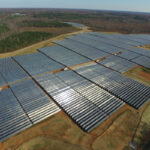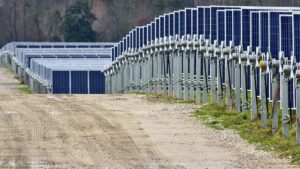
Some of Dominion Energy Virginia’s recent solar installations, despite using technology designed to track the moving sun, have turned in disappointing energy results, fueling skepticism at the State Corporation Commission toward the utility’s claims for future solar energy success.
The three units were put in service in December 2016, with a nameplate capacity of 56 megawatts. Their operations were scrutinized in the pending annual update of the rate adjustment clause that pays for them, Rider US-2. The criticism has spilled into the more important integrated resource plan case, also pending at the State Corporation Commission.
The utility persists in claiming a 25 percent capacity factory for its own solar plants, meaning they produce energy for the equivalent of one hour in four throughout the year. These units are not getting there, not on a steady basis, with the financial consequences falling on customers.
“In 2017, the actual capacity factors were 20.4%, 20.4%, and 16.7%, respectively, for the Whitehouse, Scott, and Woodland US-2 solar facilities,” stated the SCC’s Gregory Abbott in testimony in the IRP case. Abbott is deputy director of the SCC’s division of energy regulation.
“Even more troubling,” Abbott added, “is the recent non-performance of the Scott US-2 facility which has only been operational for [begin confidential [end confidential] over the September 1, 2018 through February 28, 2019 period. The Scott US-2 solar facility has been off-line for [begin confidential] [end confidential] days consecutively through February 28, 2019.”
Scott is a 17-megawatt installation in Powhatan County, Whitehouse a 20-megawatt facility in Louisa County and Woodland a 19-megawatt solar field in Isle of Wight County. Many of the problems reported at these three plants relate to transmission disruptions, not their direct operations. They are the tip of the spear for a growing presence of solar in the state, and when that solar is utility-owned that utility’s ratepayers have a high stake in their success or failure. As previously reported, in recent cases the SCC has sought to protect ratepayers from the risk if operating goals are not met.

No such consumer protections have been built into the US-2 projects, however, which are not among the Dominion generation assets offered through the PJM Interconnection, LLC system. The utility receives no capacity payments from PJM, and the SCC staff assumes that when they are not running as planned, Dominion is buying power from PJM instead.
In one test year discussed in the testimony on the US-2 case, they were projected to produce 125,000 megawatt hours of power but produced only 96,000, leaving a 29,000-megawatt hour deficit. The price of replacing that power through PJM was put at $1 million.
Solar power is also intended to bring in revenue through the sale of renewable energy certificates, or RECs. The total amount of REC revenue for these three projects is blacked out, redacted from the written testimony in the case. They don’t want us to know.
Abbot’s IRP testimony alleges that the poor performance makes the power actually produced by the solar farms prohibitively expensive.
“Since the ratepayers must pay the full revenue requirement regardless of how much energy is produced, the poor performances of the US-2 solar facilities result in ratepayers paying an average of $119.38 per MWh. This is more than triple the average PJM energy price of $34.07 per MWh if the energy had instead been procured from the PJM energy market during the hours of the US-2 facilities’ energy production. This cost premium is even more stark for some rate classes because the Company allocates costs using the average and excess demand allocator. Residential customers pay $150.95 per MWh, which is more than quadruple the average PJM energy price of $34.07.”
That is based on the 2017 performance of the three plants. Abbott continues:
“…in 2018, the actual performance of the US-2 solar facilities continued to deteriorate. The actual capacity factors were 16.2%, 13.7%, and 19.1%, respectively, for the Whitehouse, Scott, and Woodland US-2 solar facilities. Thus, the cost per MWh for next year’s US-2 RAC filing will be even more prohibitively expensive.”
The world of small, dispersed generation sources which operate or not based on the sun and wind is very different than the traditional utility model of large and steady generation plants, often under the direct control of utility operators. In a number of cases now, including this US-2 review, the SCC staff is pushing hard for a new way to allocate costs between various rate classes. Supported by the Office of Attorney General’s consumer advocates, they argue the old method is unfair to residential ratepayers and beneficial to large customers when dealing with intermittent generation.
While the US-2 plants are not selling into PJM, they reduce Dominion’s purchases from PJM. Those off-system purchases are paid for through the fuel factor, which is totally based on the amount of energy consumed. If the fuel factor cost goes down, the largest users get the most benefit. But the capital payments related to the three plants are that rate adjustment clause paid by everybody. That’s where critics see a mismatch.
In that earlier US-3 case with the Facebook-related projects, described before on Bacon’s Rebellion, the Commission affirmed the old “average and excess demand” allocation method, but started a process likely to result in changes down the line. The hearing officer in this US-2 case noted the staff’s concerns but also recommended study work before changing the allocation formula. (The ruling is here.)
He is recommending the full Commission approve a level of revenue for the US-2 operations for next year that will add about another eight cents per month, or dollar a year, to the typical (mythical) 1,000 kWh monthly customer.

Leave a Reply
You must be logged in to post a comment.